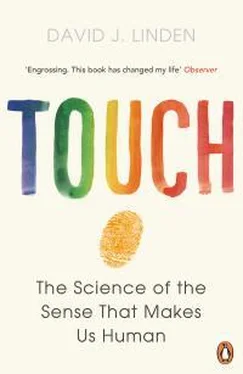Some who believe that itch is a pattern rather than a unique type of touch contend that it is merely a particular type of pain—one of a weak, dilute character. They point out, correctly, that itch and pain have certain similarities. Both can be triggered by a wide variety of stimuli: mechanical, chemical, and sometimes thermal. In particular, both pain and itch can be activated by chemical products of inflammation and can sometimes be relieved by anti-inflammatory drugs. Both are subject to strong modulation by cognitive and emotional factors, including attention, anxiety, and expectation. And both pain and itch signal the intrusion of things in the environment that should be avoided—they are, in other words, motivational sensations that demand action. Pain leads to a reflexive withdrawal response; itch leads to a reflexive scratching response. Scratching in response to itch, like withdrawal from pain to prevent tissue damage, is thought to be protective. It can cause us to dislodge venomous arthropods, like spiders, wasps, or scorpions, or those that transmit disease-causing pathogens, like malarial mosquitoes or plague-bearing fleas.
If itch were merely a weak or intermittent form of pain, then one would imagine that increasing the intensity or frequency of an itchy stimulus could raise it to the threshold of feeling painful, or, conversely, that attenuating a painful stimulus could cause it to evoke an itch sensation. However, when studied in the lab with carefully controlled stimuli, this never happens. Weak pain is just weak pain, and intense itching is just intense itching. 3Another key distinction between itch and pain involves their location on the body. While pain can be felt widely, in the skin, muscles, joints, and viscera, itching is restricted to the outer layer of the skin (both hairy and glabrous) and the mucous membranes that adjoin the skin, like those that line the mouth, throat, eyes, nose, labia minora, and anus. 4You can have pain in your guts, but not itchy guts.
If itch is, then, a unique form of touch, then one would expect to find fibers of sensory neurons in the skin that are uniquely activated by itch stimuli and that, when electrically stimulated in the lab, give rise to an itch but not a pain sensation. This is called the labeled-line theory, to distinguish it from the pattern-decoding theory, which holds that the same sensory neurons in the skin can signal either itch or pain, depending upon their electrical firing pattern. 5
In 1997 Martin Schmelz and his colleagues found the first indications of itch-specific sensory nerve fibers in humans using microneurography, the technique in which a fine electrode is passed through the skin into a sensory nerve to record the electrical activity of single fibers. They found a population of slow, unmyelinated C-fibers that responded electrically when histamine (an itch-inducing chemical that’s normally produced in the body) was applied to tiny patches of skin on the legs of volunteers. The electrical response began just as the subjects reported feeling an itch sensation at that same location. Interestingly, these fibers did not target just a small patch of skin but spread to innervate a region about three inches in diameter. Because these fibers did not respond to mechanical stimulation, they were thought to be itch-specific, supporting the labeled-line theory. However, some years later this same group of investigators found that at least some of these itch-responsive C-fibers could also be electrically activated by a pain stimulus, arguing against the labeled-line theory. 6
Part of the difficulty in interpreting these findings is that the itch stimulus used was histamine, and we know that histamine is only one of a number of different itch triggers that act through different chemical pathways. Indeed, most of us have had the experience of treating an itch with antihistamine cream and finding that it works only in some cases. We don’t know from these experiments if the nerve fibers that convey histamine-independent forms of itch are also responsive to pain. And so proof of the existence of labeled-line neurons for itch in humans remains unestablished. An important limitation of these human experiments is that one must hunt blindly with the single-fiber recording electrode: There’s no way to see inside a nerve and target a specific fiber. In mice, it’s been possible to make a great deal more progress in this area, using genetic, anatomical, and electrical recording techniques.

Many different types of stimulation of the skin can induce itch. In many cases we don’t yet have an understanding of the molecular events underlying itch transduction. For most itchy stimuli the pathway appears to be indirect. For example, when skin is repeatedly chafed or responds locally to an allergen, an inflammatory cascade is set in motion (as we discussed in chapter 6—see figure 6.5). Molecules released by immune cells, like histamine from mast cells, can bind to histamine receptors located on the bare endings of sensory neurons in the epidermis and cause them to fire electrical spikes (figure 7.2). In another example, a natural protein fragment called BAM8-22 will bind to a different receptor on itch-conducting nerve endings in the skin, which is called MrgprC11 in mice and hMrgprX1 in humans. Sometimes there can be direct activation of an itch receptor by a molecule in the environment. For example, the antimalarial drug chloroquine is well-known for producing itchy skin. Chloroquine binds directly to a different receptor in sensory neurons called MrgprA3. 7The key point is that there are at least three different molecular sensors that can activate itch-detecting neurons, and while some are directly activated by signals in the environment, most are responding to a chemical signal in the body that serves as an intermediary.

If there are truly dedicated labeled-line neurons for itch, then the following should be true: First, one should be able to destroy or silence those neurons and block itch sensation, leaving other touch senses like pain or temperature unaffected. Second, selectively activating those dedicated itch neurons should give rise to a perception of itch, but not pain or other touch sensations. Third, the anatomical distribution of the nerve endings should mirror the known distribution of itch sensation: They should be present in the epidermis of the skin and in external mucous membranes, but not in the muscles, joints, viscera, etc.
One approach to identifying potential labeled-line itch neurons is to try to determine the neurotransmitter molecule used by such itch-detecting sensory neurons to communicate with their targets in the spinal cord and then use genetic manipulation to delete that molecule in a mouse. Santosh Mishra and Mark Hoon of the National Institutes of Health did just that, making an educated guess that the transmitter of itch neurons might be a molecule called NPPB. 8When they tested an NPPB-lacking mutant mouse, they found that it had severe deficits in itch sensation evoked by a broad range of stimuli, including both histamine and chloroquine. Most important, NPPB-lacking mice had normal responses to pain, temperature, and light touch.
NPPB is released by sensory neuron terminals onto target neurons in the dorsal horn of the spinal cord. Those neurons have receptors that can bind NPPB and then propagate the electrical signal farther along toward the brain. When NPPB was artificially synthesized and injected into the spinal cord of mice, it caused the mice to scratch in a way that looked just like their response to itchy stimuli applied to the skin. After injecting a special toxin into the spinal cord that selectively destroyed neurons containing the NPPB receptor, the mice failed to respond to either itchy stimuli to the skin or to an NPPB injection in the spinal cord. These results suggest that NPPB-using neurons are a labeled line for itch. 9If that was true, then selectively activating these neurons should produce itch, but not pain or light touch sensation. At the time of this writing, that type of experiment has yet to be reported, but several laboratories are likely attempting it.
Читать дальше













